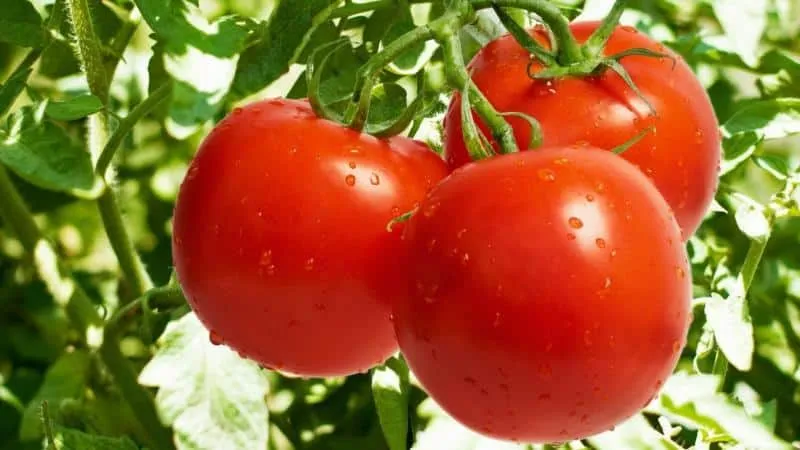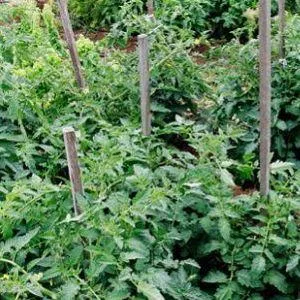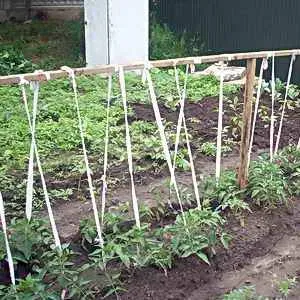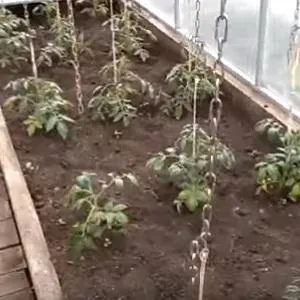After transplanting into the soil, tomato plants begin to grow vigorously. As they develop lush foliage, many varieties require additional care — staking the plants for support. Let’s explore how to properly stake tomatoes in open ground.
Table of contents
Why Stake Tomatoes?
Not all tomato plants require staking. Compact, low-growing varieties with small fruits can thrive without support. However, tall plants, those with thin or weak stems, or varieties with large fruits need extra attention.
Here are the key benefits of staking tomatoes:
- Without support, the stem may break under the sudden weight of growing foliage or developing fruits.
- Staked plants are easier to maintain — watering, fertilizing, and pruning become more convenient.
- Properly staked tomatoes allow better air circulation and sunlight penetration, essential for healthy growth.
- Plants that don’t touch the soil are less prone to diseases and pest infestations.
- Fruits remain clean and avoid rotting from contact with moist soil.
Let’s uncover some expert tips on staking tall tomato varieties effectively.
Should You Stake Tomato Clusters?
This step isn’t always necessary. If the main stem is securely staked, it’s usually sufficient — even for tall varieties. However, if you’re growing large-fruited tomatoes, supporting the fruit clusters is advisable. Staking heavy tomato clusters helps the plant sustain its yield.
Experienced gardeners recommend using cheesecloth bags for quick cluster support. These can be tied to the main stem or external supports.

Materials for Staking
Use soft materials that won’t damage the plant stems:
- Fabric strips
- Twine
- Soft rope
- Bulky knitting yarn
- Sewing ribbon
- Strips from nylon tights or stockings
Note: Avoid using thin threads, fishing line, or wire, as these can cut into the stems and harm the plants.
Support Structures for Tomatoes
The staking method depends on available materials and budget. Here are the most common techniques.
Wooden or Metal Stakes
 This is the most widespread method for staking tomatoes in open ground.
This is the most widespread method for staking tomatoes in open ground.
Stakes can be made of:
- Wood
- Metal
- Plastic
Drive the stake into the soil near the plant’s base, then tie the stem to it. Use one or two stakes per plant.
The stake should be taller than the mature plant. Secure the stem with ties at multiple points, starting from the base upwards.
Tip: Before staking, remove the lower leaves to minimize contact with the soil.
Trellis System
 Gardeners build trellises by installing vertical posts (wooden or metal) along the row, with horizontal supports between them.
Gardeners build trellises by installing vertical posts (wooden or metal) along the row, with horizontal supports between them.
Tomato plants are tied to these supports.
Some growers recommend wrapping the tie material clockwise around the stem, as tomatoes naturally follow the sun’s movement.
Wire Cage
This method works well for small-scale tomato growing (due to material costs). It allows staking without traditional stakes.
These cages can be purchased or handmade if wire is available. They resemble cylindrical or square enclosures around one to three plants.
Important: Avoid tying stems too tightly. Secure the plant at multiple points to prevent damage.
Mesh Fencing
Another stake-free method involves tying plants to metal or plastic mesh fencing. Stretch the mesh between posts along tomato rows.
Plants are secured to the mesh with soft ties.
Note: Avoid reusing tie materials year after year, as they can harbor plant diseases.
Hook and Chain System
 This method is more common in polycarbonate greenhouses but can be adapted for open ground.
This method is more common in polycarbonate greenhouses but can be adapted for open ground.
Chains are suspended from overhead supports above the plants. Tomato stems are attached to chain links using hooks on the ties.
As plants grow, the hooks are moved to higher chain links.
For open ground, install vertical supports between plants to suspend the chains.
Final Thoughts
Is staking necessary for open-ground tomatoes? It depends on the variety and plant height. Staking is crucial for tall varieties to ensure a good harvest.
Numerous staking methods exist — from simple wooden stakes to elaborate trellis systems. Most gardeners use readily available materials like stakes, wooden slats, fabric strips, or old tights. The method can be adapted for both open ground and greenhouse cultivation. Remember to avoid materials that might damage the plants, such as thin wires or fishing lines.







